|
|
Captain Jack, the real Tex Willer
(La Liguria, Published on Saturday, June 1, 2002)
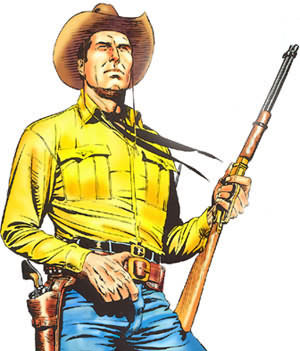 The Comanches called him "the white devil"
and they had a sacred terror of him. The Mexicans, who, when they heard his
name mentioned, made the sign of the cross, defined him as "the Texan devil".
For everyone, however, he was the most feared and respected Texas Ranger who
ever existed.
The Comanches called him "the white devil"
and they had a sacred terror of him. The Mexicans, who, when they heard his
name mentioned, made the sign of the cross, defined him as "the Texan devil".
For everyone, however, he was the most feared and respected Texas Ranger who
ever existed.
No, we are not speaking about Tex Willer, the hero of the most famous comic
strip of Italy.
The fearless gunman who has accompanied the adolescence of entire generations,
and who recently has given revival to his popularity thanks to the microphones
of the Italian national radio broadcasting, is not only a paper hero. The character
born from the creative fantasy of Gianluigi Bonelli seems in fact to adapt itself
perfectly to the life of the personality who passed in history as the most famous
Texas Ranger of all times, a man who became a living legend to such an extent
that in 1848, when he was only 31 years old, the state of Texas gave his name
to a new County.
John Coffee Hays, that was his name, is still today known throughout the United
States as Captain Jack. That Bonelli was inspired by him to sketch the figure
of Tex Willer is most probable seeing the numerous likenesses between the hero
of the comic strip and those of the real one in flesh and bones. Like Tex, also
Hays was a man of simple ways (disliked uniforms and formalisms) even if behind
his modesty he hid the courage of a lion and an incredible ability as a fighter.
Like Tex, also 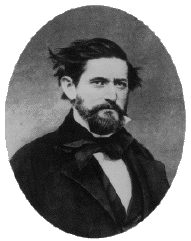 Hays
had as a partner and friend an Indian chief who stayed by his side in thousands
of battles: Tex's one was Navajo Tiger Jack, Hays' one was Lipan Flacco. Like
Tex, Hays was considered an Indian chief (even if they were Lipan and not Navajo)
and his sworn enemies were the bloody-thirsty Comanches and the Mexican bandits
who infested Texas. Like Tex, also Hays received from the American Federal Government
the nomination of Indian Agent of the Gila River Country. Like Tex, Hays was
known for his extraordinary qualities of a scout. Like Tex, after all, he was
a contemporary of another famous character of the West, Kit Carson, whom he
met and who (as in the comic strip) was not much older than him being only nine
years older.
Hays
had as a partner and friend an Indian chief who stayed by his side in thousands
of battles: Tex's one was Navajo Tiger Jack, Hays' one was Lipan Flacco. Like
Tex, Hays was considered an Indian chief (even if they were Lipan and not Navajo)
and his sworn enemies were the bloody-thirsty Comanches and the Mexican bandits
who infested Texas. Like Tex, also Hays received from the American Federal Government
the nomination of Indian Agent of the Gila River Country. Like Tex, Hays was
known for his extraordinary qualities of a scout. Like Tex, after all, he was
a contemporary of another famous character of the West, Kit Carson, whom he
met and who (as in the comic strip) was not much older than him being only nine
years older.
But let's try and dig a bit deeper into the history of this Ranger. John Coffee
Hays was born on January 28, 1817 in Little Cedar Lick, in Wilson County of
the State of Tennessee, first born of six sons of Harmon Hays and Elizabeth
Cage. It was his father who chose to name him like this in memory of his commanding
officer, that is, General John Coffee, of the troops in which he had fought
the War of Independence against the English with the degree of Lieutenant. After
having attended the Davidson Academy of Nashville, young Hays longs for Texas.
It is 1837. A year before, exactly on the night of March 6, 1836, nearly 180
Americans under the command of William Barret Travis let themselves be slaughtered
in the Mission of Alamo by the soldiers of the Mexican General Antonio Lò
pez de Santa Anna.
Among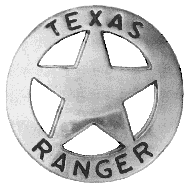 the heroic victims is also another famous son of the State of Tennessee, Colonel
David Crockett, former Deputy of the United States. Jack, as he was called since
he was a boy because of the nickname that the paternal grandfather Robert had
given him, passes the border of Texas at Nacogdoches and enlists himself in
the Rangers under the command of Erastus (Deaf) Smith, in service from San Antonio
to Rio Grande. The baptism of the fire takes place exactly on the Rio Grande
where the Rangers engage in battle with the Mexican cavalry and they defeat
it. Jack distinguishes himself to such a point that he is nominated Sergeant
on the field. It is the first of a long series of promotions. In fact, battle
after battle, Jack earns the respect of his superiors and soon reaches, wère
in 1839, the degree of Captain. Captain Jack, as he is now called by friends
and enemies, has the exact task to protect the American colonists from the incursions
of the Comanche and the Mexican bandits who terrorize the frontier. His action
is capillary and his turn out is militarily amazing. An example is the capture,
rather enlivened, of a famous a Mexican bandit, Juan Sanchez. During a turn
of reconnaissance in the surroundings of the Rio Grande, Hays was informed by
the owner of a ranch that on the opposite side of the river there was a group
of Mexican bandits. Being that the river could be waded across only at one point,
at sunset Hays and his Rangers hid in between the trees in order to ambush the
bandits. All seemed to go well when, just while the bandits were crossing the
Rio Grande, a Ranger inadvertently blew a shot from his gun and the Mexicans
began to shoot. In the shooting that followed a Texan was wounded and three
Mexicans were killed. Fearing to make the same end as their companions, other
four Mexicans tried to go back, chased right away by Hays and an other Ranger.
Seeing that the pursuers were only two, the four stopped and tried to shoot
them, but Hays centered one right away and killed him on the spot. The other
three abandoned the riverbed and spurred the horses towards the prairie where
they could run better.
the heroic victims is also another famous son of the State of Tennessee, Colonel
David Crockett, former Deputy of the United States. Jack, as he was called since
he was a boy because of the nickname that the paternal grandfather Robert had
given him, passes the border of Texas at Nacogdoches and enlists himself in
the Rangers under the command of Erastus (Deaf) Smith, in service from San Antonio
to Rio Grande. The baptism of the fire takes place exactly on the Rio Grande
where the Rangers engage in battle with the Mexican cavalry and they defeat
it. Jack distinguishes himself to such a point that he is nominated Sergeant
on the field. It is the first of a long series of promotions. In fact, battle
after battle, Jack earns the respect of his superiors and soon reaches, wère
in 1839, the degree of Captain. Captain Jack, as he is now called by friends
and enemies, has the exact task to protect the American colonists from the incursions
of the Comanche and the Mexican bandits who terrorize the frontier. His action
is capillary and his turn out is militarily amazing. An example is the capture,
rather enlivened, of a famous a Mexican bandit, Juan Sanchez. During a turn
of reconnaissance in the surroundings of the Rio Grande, Hays was informed by
the owner of a ranch that on the opposite side of the river there was a group
of Mexican bandits. Being that the river could be waded across only at one point,
at sunset Hays and his Rangers hid in between the trees in order to ambush the
bandits. All seemed to go well when, just while the bandits were crossing the
Rio Grande, a Ranger inadvertently blew a shot from his gun and the Mexicans
began to shoot. In the shooting that followed a Texan was wounded and three
Mexicans were killed. Fearing to make the same end as their companions, other
four Mexicans tried to go back, chased right away by Hays and an other Ranger.
Seeing that the pursuers were only two, the four stopped and tried to shoot
them, but Hays centered one right away and killed him on the spot. The other
three abandoned the riverbed and spurred the horses towards the prairie where
they could run better.
But b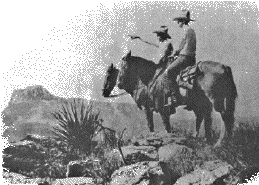 y
now it was late: Hays and his Rangers surrounded them and the bandits, seeing
the uselessness of defence, surrendered. One of them was in fact the famous
Juan Sanchez that ended up being hanged along with his partners.
y
now it was late: Hays and his Rangers surrounded them and the bandits, seeing
the uselessness of defence, surrendered. One of them was in fact the famous
Juan Sanchez that ended up being hanged along with his partners.
Another big problem for the Texas Rangers was due to certain Indian tribes who
raged against the American colonists with an excessive cruelty even for those
times. It's the case of what happened one day near San Felipe when a boy on
horse reached the general quarters of Hays announcing the umpteenth slaughter.
"Down there - he said gasping after having come down with a jump from the
horse - the Comanche exterminated a family…". In just a few minutes Captain
Jack and his men were on the spot. Among the smoking ruins of the house the
Rangers found the bodies of two children killed by tomahawk blows: both of them
had been scalped. The body of the father was lying some meters ahead , he too
had been scalped, killed by two blows of firearm in the chest. The mother, who
during the attack had been hit in the head and had lost her senses, had saved
herself miraculously and now was rambling desperate , crying and screaming,
embracing first one body and then the other. "My child, my child… - she
said sobbing to Hays – they took her away . Save her, I plead you ".
Indeed the Comanche, after having killed the males of the family, had kidnapped
a 17 year old girl. Hays did not loose time and together with his Rangers he
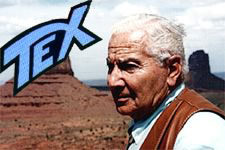 immediately
set out to track the Indians. Perhaps because they did not think they were being
followed , the Comanche had not taken excessive precautions and were tracked
down within a few hours in an encampment near the Llano River. The Rangers were
not that many to be sure to defeat the Indian plunderers so at that point Hays
addressed them with much frankness. "Boys – he said- it's probable
that some of us will loose a little bit of blood today, but stay perfectly calm.
Show your usual courage and I have no doubt of the outcome". Therefore,
with the revolver in his right hand, he gave them the attack signal: "Let's
go !". At Hays' order, the Rangers, arranged in a fan-like manner and armed
with Colt Paterson cylinders, of five blows, charged the Indians shooting like
mad.
immediately
set out to track the Indians. Perhaps because they did not think they were being
followed , the Comanche had not taken excessive precautions and were tracked
down within a few hours in an encampment near the Llano River. The Rangers were
not that many to be sure to defeat the Indian plunderers so at that point Hays
addressed them with much frankness. "Boys – he said- it's probable
that some of us will loose a little bit of blood today, but stay perfectly calm.
Show your usual courage and I have no doubt of the outcome". Therefore,
with the revolver in his right hand, he gave them the attack signal: "Let's
go !". At Hays' order, the Rangers, arranged in a fan-like manner and armed
with Colt Paterson cylinders, of five blows, charged the Indians shooting like
mad.
The Comanche did not indeed expect that attack . When the Rangers headed towards
the field, the warriors went quickly in search of their firearms, but the surprise
effect had worked and it was panic. Disorderly and without a guide, the Indians
mounted their horses and escaped in the forest. Only then Hays made the point
of the situation: In the attack two of his men were killed , five were wounded.
The Indians had left five warriors on the field. But, nobody, had seen the girl.
They found her a little later on, she too massacred by blows of the tomahawk:
the Comanche, seeing that they couldn't bring her with them, had preferred to
kill her. The body was so torn in pieces that some of the Rangers, seeing it,
started to cry. Hays made her be buried close to a precipice in the canyon of
the Llano River.
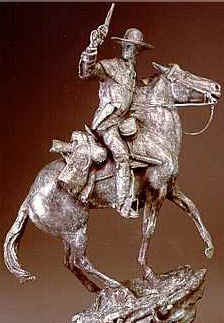 Captain Jack
was named Colonel in 1846 when he was entrusted with a regiment of Rangers in
occasion of the war between the United States and Mexico.
Captain Jack
was named Colonel in 1846 when he was entrusted with a regiment of Rangers in
occasion of the war between the United States and Mexico.
In order to understand what type of relationship existed between "los diablos
tejanos", and that is to say, the Texan devils, as Texas Rangers were called
by the Mexicans, it's enough to cite an episode that happened in Mexico City
when the Rangers on horse entered in column, Hays in lead. As soon as the inhabitants
realized that those that were parading were the hated Rangers (did not have
uniforms and were armed from head to toe ), a man took a stone and hurled it
against one of them. The reply was immediate: the picked on Ranger suddenly
took out the Colt and killed the man on the spot. Therefore, without moving
a hair, put back the gun and calmly went on his way. As a result of this episode,
General Winfleld Scott called Hays to report, asking him to give reasons for
what had happened. "Therès nothing to say - Hays replied –simply
that the Texas Rangers do not allow anyone to insult or hit them."
What more made an impression of Hays for those who did not know him was his
physical aspect. Here is as how one of his contemporaries remembers him, Samuel
C. Reid, to whom he was introduced in March of 1846.
"We had heard so much of Colonel Hays that we were anxious to be introduced
to the commander of our regiment. The quarters of Lieutenant Forbes Britton,
commissary of subsistence, was at that time the generai rendezvous of all officers….
We saw a group of gentiemen sitting around, among whom were Gen. Lamar, Gov.
Henderson… we tried to singie out the celebrated partisan chief, and were
much surprised when we were presented to a delicate looking young man, of about
five feet eight inches in stature, and was told that he was our colonel.
He was dressed very plainly, and wore a thin jacket, with the usual Texan hat,
broad-brimmed with a round top, and loose open collar, with a biack handkerchief
tied negligently around his neck. He had dark brown hair, a large and brilliant
hazei eye, which
is restless in conversation and speaks a language of its own not to be mistaken,
and very prominent and heavy arched eyebrows. His broad deep forehead is well
developed; he has a Roman nose, with a finely curved nostril; a iarge mouth,
with the corners tending downwards; a short upper hp, whiie the under one pro
jects slightiy, indicative of great firmness and determination. He is naturaily
of a fair complexion, but from long exposure on the frontier, has become dark
and weather-beaten. He has rather a thoughtful and careworn expression, from
the constant exercise of his facuities and his long acquaintance with dangers
and difficulties; the responsibilities of a commander, have given an habitual
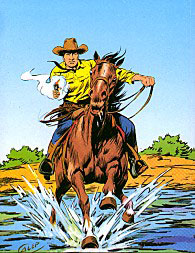 frown when his features are in
repose. He wears no whiskers, which gives him a still more youthful appearance…
his manners are bland and very prepossessing, from his extreme modesty.
frown when his features are in
repose. He wears no whiskers, which gives him a still more youthful appearance…
his manners are bland and very prepossessing, from his extreme modesty.
So great is his reputation among the Mexicans that he is everywhere known as
Captain Jack. Notwithstanding bis rigid discipline, for bis word is law among
his men, he is a bland and pleasant companion when off duty, and the men familiarly
cali him "Jack," though there is that about the man which prevents
one from taking the slightest liberty with him." .
At the end of the war, when by then the nomination to 2-star General was coming
his way, Hays decided that the moment had come to retire. He was 32 years old
and by now a living legend, keeping in mind that the average life of a Ranger
at that time was almost of two years in service before being killed. And it
was just in that period that Texas entitled him a new County. But, at the peak
of success, he understood that luck could not last forever on the battlefield,
so he married Susan Calvert, a girl from a good family who he had met a couple
of years before, and moved to California where for four years he was the Sheriff
of San Francisco County. He left the star because in 1853 President Franklin
Pierce named him Surveyor General of California. In his new role he was also
among the founders of the city of Oakland and in 1876 entered in politics as
delegate in the National Convention of the Democratic Party. In the meantime
the wife had given him three boys and three girls and the family lived in a
splendid ranch in Piedmont, always in California, where on April 25,1883, at the age of 66, he died as a consequence of pains in the joints that
he accumulated during his adventurous Texan youth. But for the Americans, Captain
Jack is still alive and there is who swears that in the nights of full moon
someone still sees his ghost, in saddleback of a black horse, galloping on the
exterminated prairie of Texas hunting down bandits and Comanches. Just like
Tex.
Translated by Christina Garra Iorio
© ALL REPRODUCTION RIGHTS RESERVED
My Books | My Articles | Events & News | Multimedia
Facebook | X | YouTube | Instagram | Contact
© 2001-2025 Rino Di Stefano – Partial or total reproduction prohibited without permission
Copyright Statement – Privacy Policy






